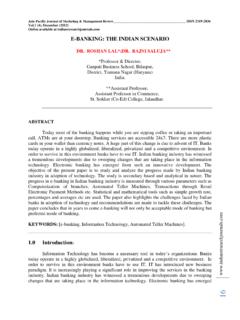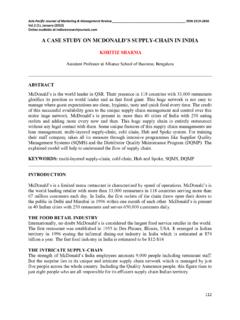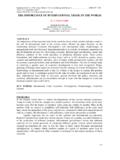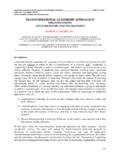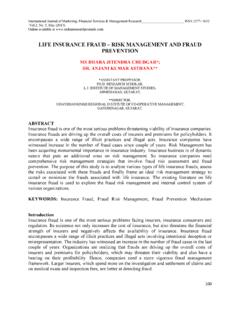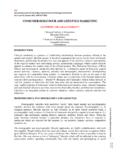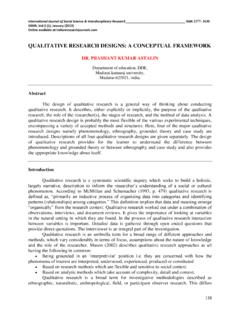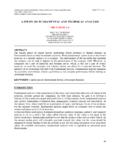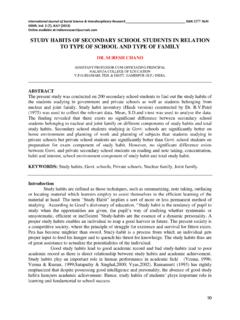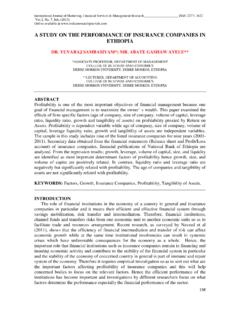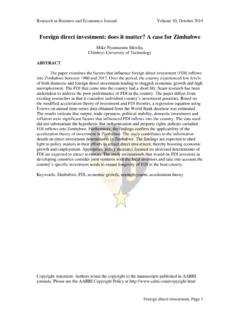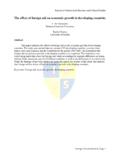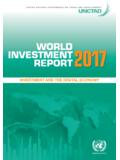Transcription of R. ANITHA* - INDIAN RESEARCH JOURNALS
1 IRJC International Journal of Marketing, Financial Services & Management RESEARCH Issue 8, August 2012, ISSN 2277 3622 108 foreign direct INVESTMENT AND ECONOMIC GROWTH IN INDIA R. anitha * *Assistant Professor, Anna Adarsh College for Women, Chennai, Tamil Nadu, India. ABSTRACT foreign direct Investment (FDI) plays a very important role in the development of the nation. It is very much vital in the case of underdeveloped and developing countries. A typical characteristic of these developing and underdeveloped economies is the fact that these economies do not have the needed level of savings and income in order to meet the required level of investment needed to sustain the growth of the economy. In such cases, foreign direct investment plays an important role of bridging the gap between the available resources or funds and the required resources or funds.
2 It plays an important role in the long-term development of a country not only as a source of capital but also for enhancing competitiveness of the domestic economy through transfer of technology, strengthening infrastructure, raising productivity and generating new employment opportunities. In India, FDI is considered as a developmental tool, which helps in achieving self-reliance in various sectors and in overall development of the economy. India after liberalizing and globalizing the economy to the outside world in 1991, there was a massive increase in the flow of foreign direct investment. This paper analyses FDI inflow into the country during the Post Liberalization period. Further, the trends of FDI inflow into the country are projected for a period of five years from 2010-11 to 2014-15 using Autoregressive Integrated Moving Average (ARIMA) forecasting technique.
3 The paper tries to examine the various set of factors which influence the flow of FDI Identifying the causes for low inflow and suggestive remedial measures to increase the flow of FDI in India with that of other developing nations in the world. KEYWORDS: Determining factors, foreign direct Investment, Pre & Post Liberalization period. _____ INTRODUCTION foreign direct investment (FDI) has played an important role in the process of globalization during the past two decades. The rapid expansion in FDI by multinational enterprises since the mid-eighties may be attributed to significant changes in technologies, greater liberalization of trade and investment regimes, and deregulation and privatization of markets in many countries including developing countries like India. Capital formation is an important determinant of economic growth.
4 While domestic investments add to the capital stock in an economy, FDI plays a complementary role in overall capital formation and in filling the gap between domestic savings and investment. At the macro-level, FDI is a non-debt-creating source of additional IRJC International Journal of Marketing, Financial Services & Management RESEARCH Issue 8, August 2012, ISSN 2277 3622 109 external finances. At the micro-level, FDI is expected to boost output, technology, skill levels, employment and linkages with other sectors and regions of the host economy. In India FDI inflow made its entry during the year 1991-92 with the aim to bring together the intended investment and the actual savings of the country. To pursue a growth of around 7 percent in the Gross Domestic Product of India, the net capital flows should increase by at least 28 to 30 percent on the whole.
5 But the savings of the country stood only at 24 percent. The gap formed between intended investment and the actual savings of the country was lifted up by portfolio investments by foreign Institutional Investors, loans by foreign banks and other places, and foreign direct investments. Among these three forms of financial assistance, India prefers as well as possesses the maximum amount of foreign direct Investments. Hence FDI is considered as a developmental tool for growth and development of the country. Therefore, this study is undertaken to analyze the flow of FDI into the country identifying the various set of factors which determine the flow of FDI. REVIEW OF LIERATURE Balasundaram Maniam and Amitiava Chatterjee (1998) studied on the determinants of US foreign investment in India; tracing the growth of US FDI in India and the changing attitude of the INDIAN Government towards it as a part of the liberalization program.
6 Nagesh Kumar (2001) concluded that the magnitudes of inflows have recorded impressive growth, as they are still at a small level compared to the country s potential. and Vidya Mahambre (2003) concluded that FDI is a very good means for the transfer of technology and knowhow to the developing countries. Birendra Kumar and Surya Dev (2003) with the data available in the INDIAN context showed that the increasing trend in the absolute wage of the worker does not deter the increasing flow of FDI. Laura Alfaro (2003) finds that FDI flows into the different sectors of the economy (namely primary, manufacturing, and services) exert different effects on economic growth. FDI inflows into the primary sector tend to have a negative effect on growth, whereas FDI inflows in the manufacturing sector a positive one. Evidence from the foreign investments in the service sector is ambiguous.
7 Sebastin Morris (2004) has discussed the determinants of FDI over the regions of a large economy like India. He argues that, for all investments it is the regions of metropolitan cities that attract the bulk of FDI. Peng Hu (2006) analyses various determinants that influence FDI inflows in India which include economic growth, domestic demand, currency stability, government policy and labour force availability against other countries that are attracting FDI inflows. Analyzing the new findings, it is observed that India has some competitive advantages in attracting FDI inflows, like a large pool of high quality labour force which is an absolute advantage of India against other developing countries like China and Mexico. Chandana Chakraborty and Peter Nunnenkamp (2008) said that booming foreign direct investment in post-reform India is widely believed to promote economic growth.
8 Chew Ging Lee (2009) has pointed out that GDP per capita has a positive effect on FDI inflows in the long run. Krishna Chaitanya Vadlamannatia, Artur Tamazianb and Lokanandha Reddy Iralac (2009) analyses about the determinants of FDI in Asian economies. The determinants are analyzed under four heads, viz. economic and policy factors, socioeconomic factors, institutional factors and political factors. The findings in the baseline models show that poor socioeconomic conditions and labour-related issues are the major determinants. and IRJC International Journal of Marketing, Financial Services & Management RESEARCH Issue 8, August 2012, ISSN 2277 3622 110 (2009) have made a comparison of FDI inflows during pre and post liberalization period, country-wise, sector-wise and region-wise. Subash Sasidharan and Vinish Kathuria (2011) examine the relationship between FDI and R&D of the domestic firms in the post-liberalization regime.
9 OBJECTIVES This study is based on the following objectives- To compare FDI inflow during the post liberalization period with pre liberalization period and to forecast FDI inflow to India for a future period of 5 years. To identify the factors which influence the flow of FDI in India. To identify the problems relating to inflow of FDI and to make suitable suggestions for attracting more FDI inflow to India. METHODOLOGY SOURCES OF DATA COLLECTION The study is based on published sources of data collected from various sources. The data was extracted from the following sources: Handbook of Statistics on the INDIAN economy, RBI, various issues Economic Survey, Government of India, various issues Department of Industrial Policy and Promotion (DIPP) Secretariat of Industrial Assistance (SIA) Central Statistical Organization (CSO) PERIOD OF STUDY The magnitude of FDI inflows is analyzed during the Pre and Post Liberalization period, hence the study is undertaken for a period of 30 years from 1980-81 to 2009-10.
10 The factors which influence the flow of FDI into the country is analyzed during the Post Liberalization period , from 1991 to 2010. TOOLS USED FOR ANALYSIS The Annual Growth Rate (AGR) and Compounded Annual Growth Rate (CAGR) are used to analyze the FDI inflows during the Pre and Post Liberalization period to find out the magnitude of FDI inflows. Further, Autoregressive Integrated Moving Average (ARIMA) model is used to IRJC International Journal of Marketing, Financial Services & Management RESEARCH Issue 8, August 2012, ISSN 2277 3622 111 forecast FDI inflows. Factors which influence FDI into India are analyzed by using Multiple Regression analysis. FDI INFLOWS DURING PRE & POST LIBERALIZATION PERIOD IN INDIA The first objective on which the study is made is to analyze the magnitude of FDI inflows in India. In this context, the period of study from 1980-81 to 2009-10 is divided into two phases, Phase I is the Pre-Liberalization period, that is, FDI inflows from 1980-81 to 1990-91 are taken into account.
